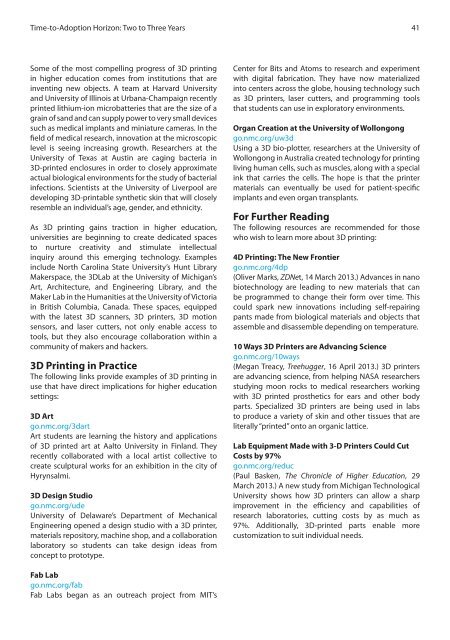NMC Horizon Report > 2014 Higher Education Edition
You also want an ePaper? Increase the reach of your titles
YUMPU automatically turns print PDFs into web optimized ePapers that Google loves.
Time-to-Adoption <strong>Horizon</strong>: Two to Three Years<br />
41<br />
Some of the most compelling progress of 3D printing<br />
in higher education comes from institutions that are<br />
inventing new objects. A team at Harvard University<br />
and University of Illinois at Urbana-Champaign recently<br />
printed lithium-ion microbatteries that are the size of a<br />
grain of sand and can supply power to very small devices<br />
such as medical implants and miniature cameras. In the<br />
field of medical research, innovation at the microscopic<br />
level is seeing increasing growth. Researchers at the<br />
University of Texas at Austin are caging bacteria in<br />
3D-printed enclosures in order to closely approximate<br />
actual biological environments for the study of bacterial<br />
infections. Scientists at the University of Liverpool are<br />
developing 3D-printable synthetic skin that will closely<br />
resemble an individual’s age, gender, and ethnicity.<br />
As 3D printing gains traction in higher education,<br />
universities are beginning to create dedicated spaces<br />
to nurture creativity and stimulate intellectual<br />
inquiry around this emerging technology. Examples<br />
include North Carolina State University’s Hunt Library<br />
Makerspace, the 3DLab at the University of Michigan’s<br />
Art, Architecture, and Engineering Library, and the<br />
Maker Lab in the Humanities at the University of Victoria<br />
in British Columbia, Canada. These spaces, equipped<br />
with the latest 3D scanners, 3D printers, 3D motion<br />
sensors, and laser cutters, not only enable access to<br />
tools, but they also encourage collaboration within a<br />
community of makers and hackers.<br />
3D Printing in Practice<br />
The following links provide examples of 3D printing in<br />
use that have direct implications for higher education<br />
settings:<br />
3D Art<br />
go.nmc.org/3dart<br />
Art students are learning the history and applications<br />
of 3D printed art at Aalto University in Finland. They<br />
recently collaborated with a local artist collective to<br />
create sculptural works for an exhibition in the city of<br />
Hyrynsalmi.<br />
3D Design Studio<br />
go.nmc.org/ude<br />
University of Delaware’s Department of Mechanical<br />
Engineering opened a design studio with a 3D printer,<br />
materials repository, machine shop, and a collaboration<br />
laboratory so students can take design ideas from<br />
concept to prototype.<br />
Center for Bits and Atoms to research and experiment<br />
with digital fabrication. They have now materialized<br />
into centers across the globe, housing technology such<br />
as 3D printers, laser cutters, and programming tools<br />
that students can use in exploratory environments.<br />
Organ Creation at the University of Wollongong<br />
go.nmc.org/uw3d<br />
Using a 3D bio-plotter, researchers at the University of<br />
Wollongong in Australia created technology for printing<br />
living human cells, such as muscles, along with a special<br />
ink that carries the cells. The hope is that the printer<br />
materials can eventually be used for patient-specific<br />
implants and even organ transplants.<br />
For Further Reading<br />
The following resources are recommended for those<br />
who wish to learn more about 3D printing:<br />
4D Printing: The New Frontier<br />
go.nmc.org/4dp<br />
(Oliver Marks, ZDNet, 14 March 2013.) Advances in nano<br />
biotechnology are leading to new materials that can<br />
be programmed to change their form over time. This<br />
could spark new innovations including self-repairing<br />
pants made from biological materials and objects that<br />
assemble and disassemble depending on temperature.<br />
10 Ways 3D Printers are Advancing Science<br />
go.nmc.org/10ways<br />
(Megan Treacy, Treehugger, 16 April 2013.) 3D printers<br />
are advancing science, from helping NASA researchers<br />
studying moon rocks to medical researchers working<br />
with 3D printed prosthetics for ears and other body<br />
parts. Specialized 3D printers are being used in labs<br />
to produce a variety of skin and other tissues that are<br />
literally “printed” onto an organic lattice.<br />
Lab Equipment Made with 3-D Printers Could Cut<br />
Costs by 97%<br />
go.nmc.org/reduc<br />
(Paul Basken, The Chronicle of <strong>Higher</strong> <strong>Education</strong>, 29<br />
March 2013.) A new study from Michigan Technological<br />
University shows how 3D printers can allow a sharp<br />
improvement in the efficiency and capabilities of<br />
research laboratories, cutting costs by as much as<br />
97%. Additionally, 3D-printed parts enable more<br />
customization to suit individual needs.<br />
Fab Lab<br />
go.nmc.org/fab<br />
Fab Labs began as an outreach project from MIT’s



